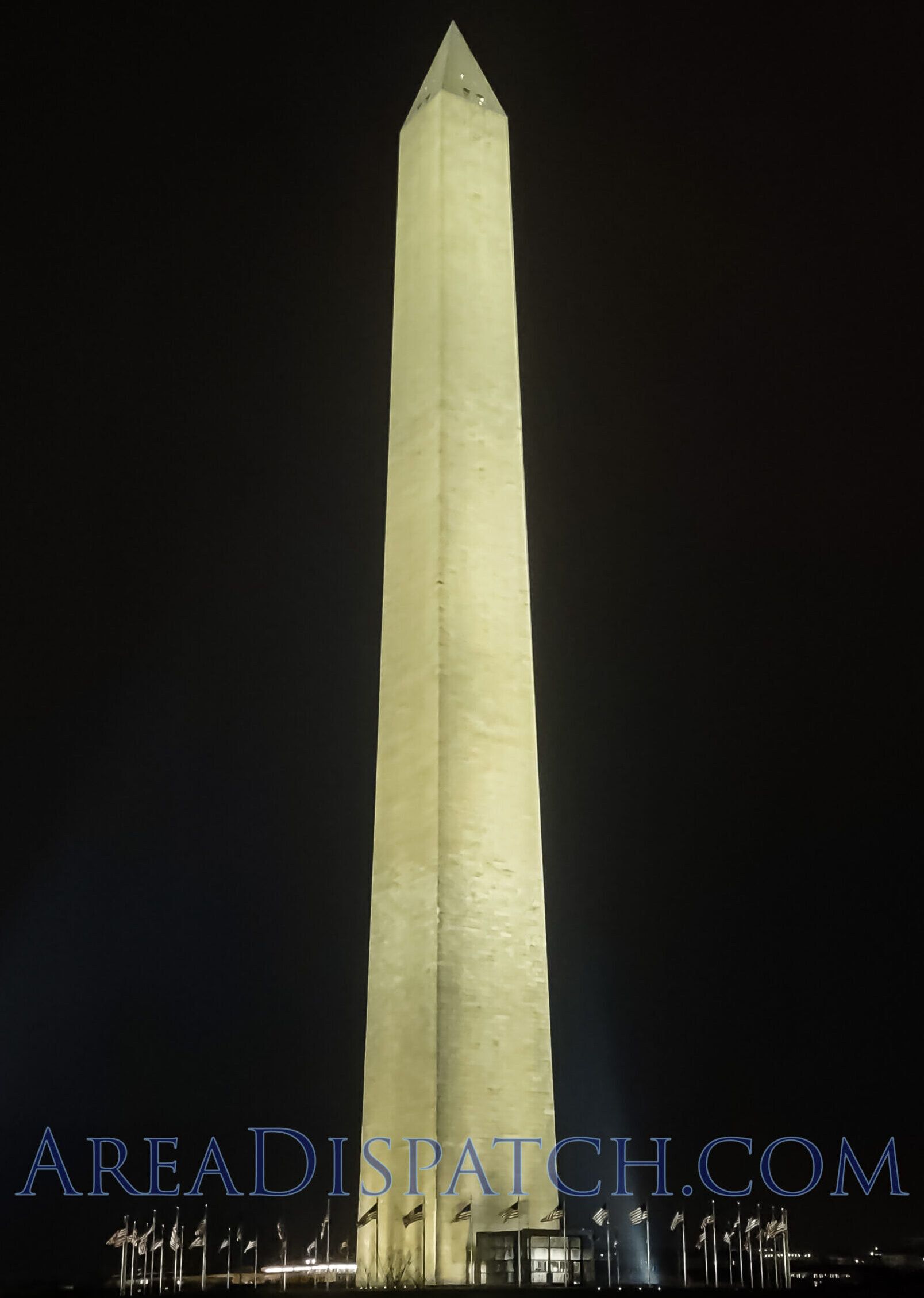The Lost Cause of the Confederacy is comprised of six parts. Monuments in honor of the Confederacy are consistent with their adherence to the Lost Cause ideology and promote the tenets of the myth. It was spread for so long that these tenets are fully believed and embraced by many, even by many well-educated on the subject. Recently, Ron Desantis was admonished for saying that slaves benefited from slavery. This is one part of the Lost Cause Myth that has been spoken through oral histories and even taught in many classrooms. Former South Carolina Governor and another Presidential candidate, Nicki Haley, wasn’t able to name slavery as the cause of the Civil War because of the Lost Cause Myth.
Recognizing Lost Cause rhetoric for what it is can be difficult, but through quality education and by dispelling the parts of this myth when they are presented, we can overcome the concept meant to divide. Acceptance of or indifference to this damaging and divisive rhetoric when it is spoken, written, or when it appears anywhere teaches those that lack understanding of the myth that it is true. This is what our children take from your silence.
To learn more about the Lost Cause, please see the resource links posted at the bottom of this page.
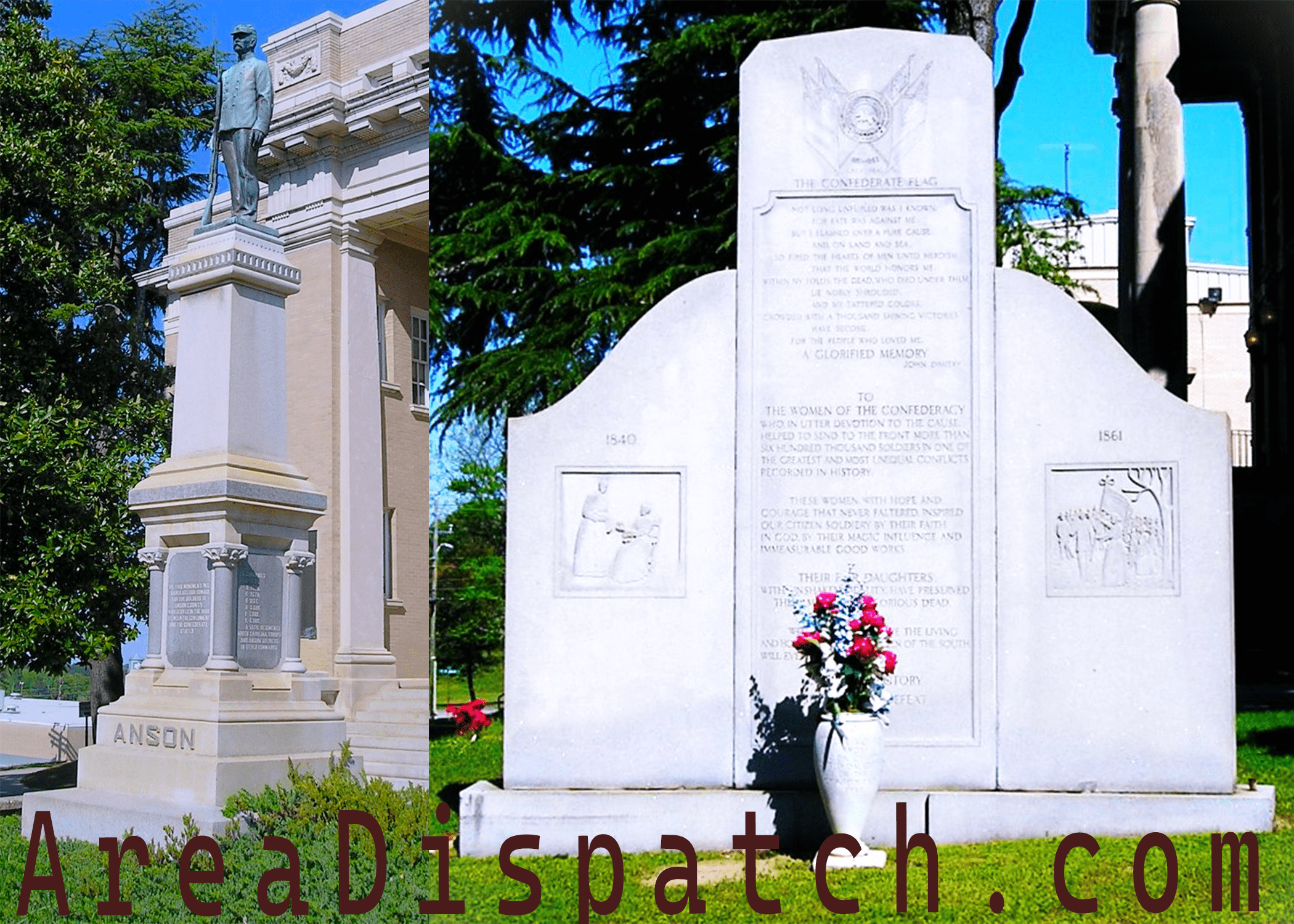
“X. I direct my Executor to erect a monument on the Court House lot in Wadesboro, N.C. at a cost of $2000, not to exceed three thousand dollars to my mother Eliza Sydnor Smith, to my wife Mary Bennet Smith, naming them on said monument, and to the women of the Confederacy.“
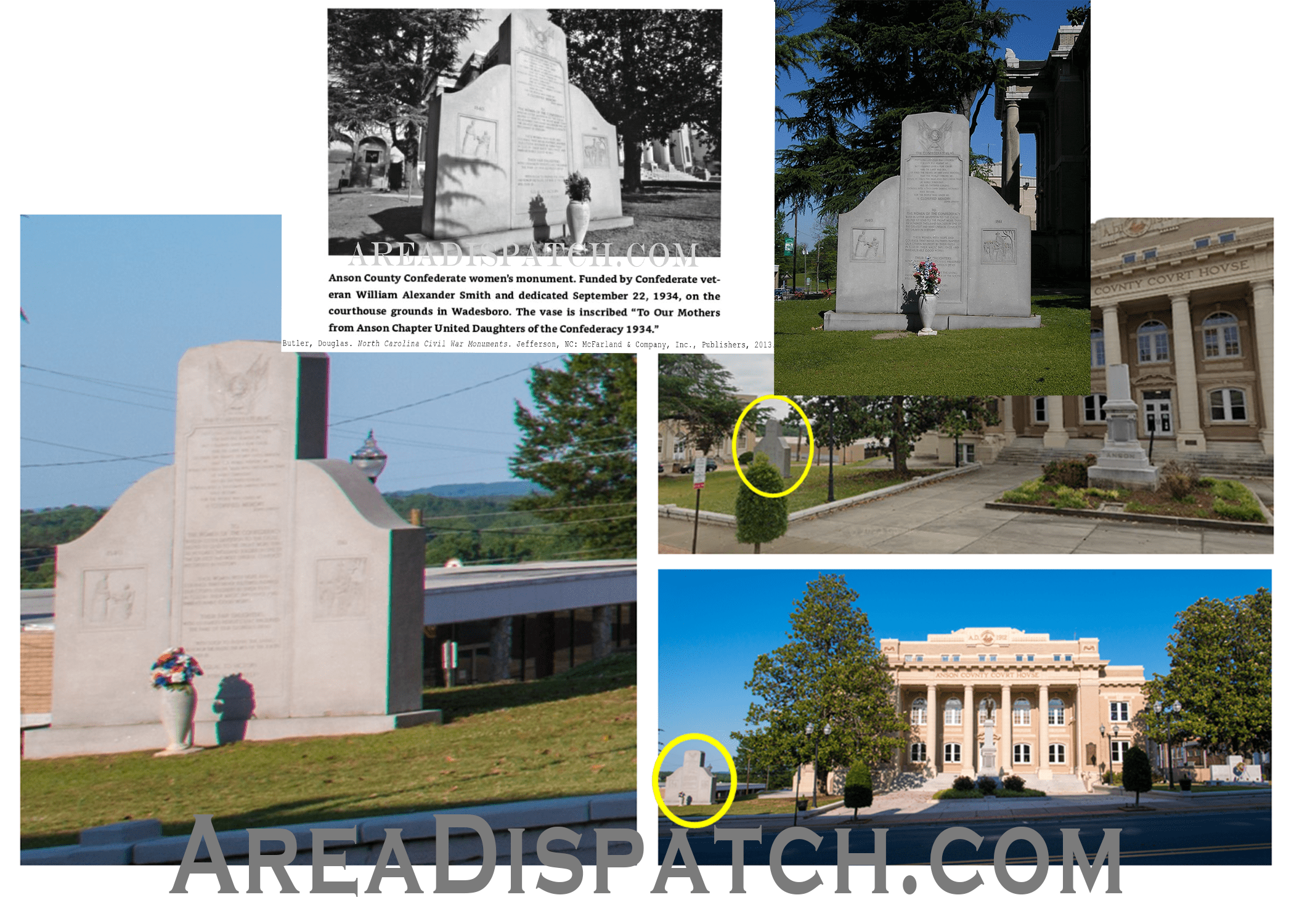
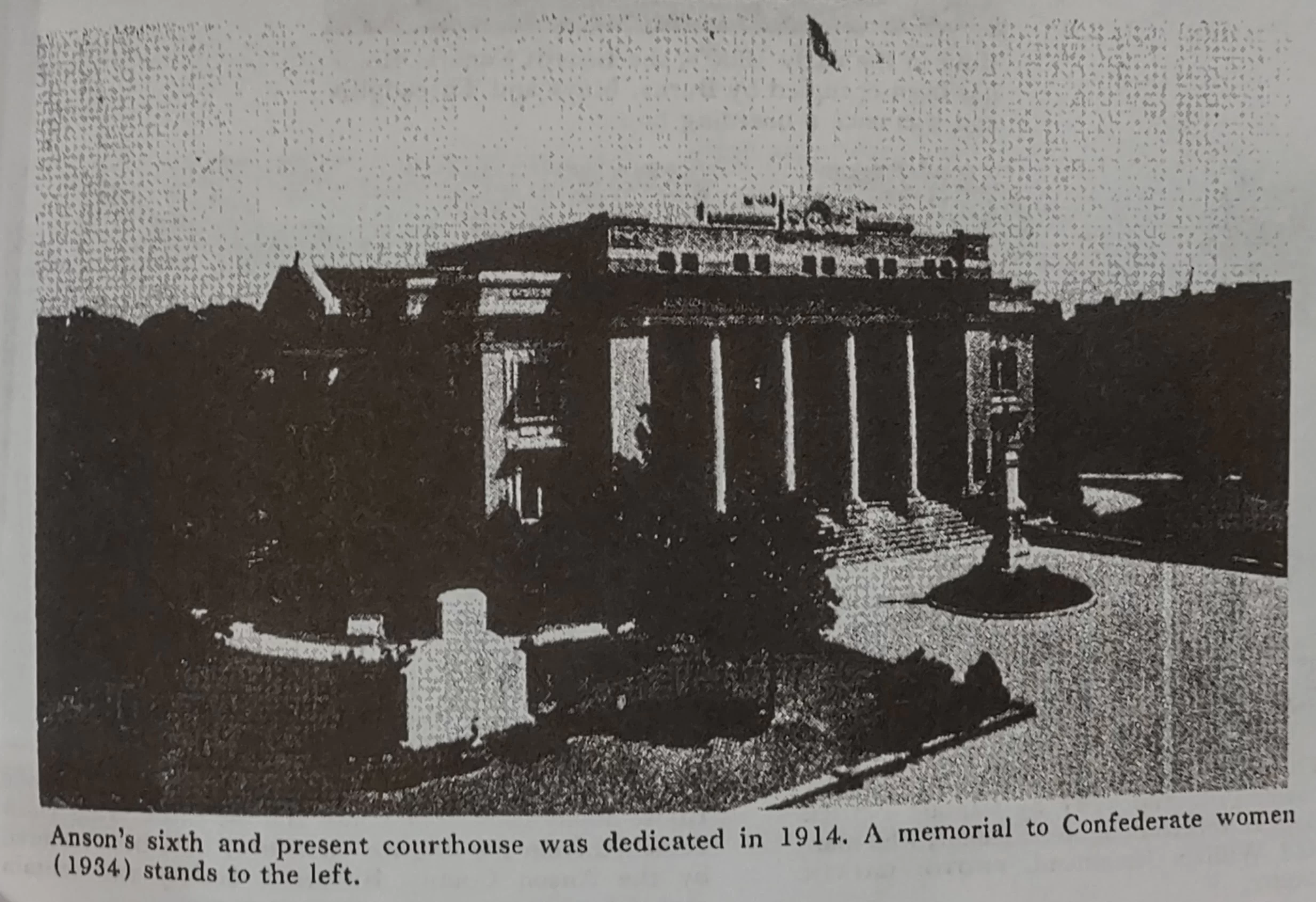
The monument directed in item X of Smith’s will is in the bottom left side of this photograph. William Alexander Smith provided both of these monuments that are just feet apart and surely have more foot traffic than any other location in the county. Also, the soldiers’ monument was moved from its originally erected location without any documentation or anyone ever mentioning the move. One person.

This is the monument that provided the poem from the Causes: Lost & Found page at the beginning. The ideology inspiring the poem was briefly covered, and there has been verification provided of the sentiment held by the donor of this monument and the monument for Confederate soldiers. Once again, both monuments stand in front of the Anson County Courthouse.
How this monument has gone unnoticed is a testament to the power of imagery:
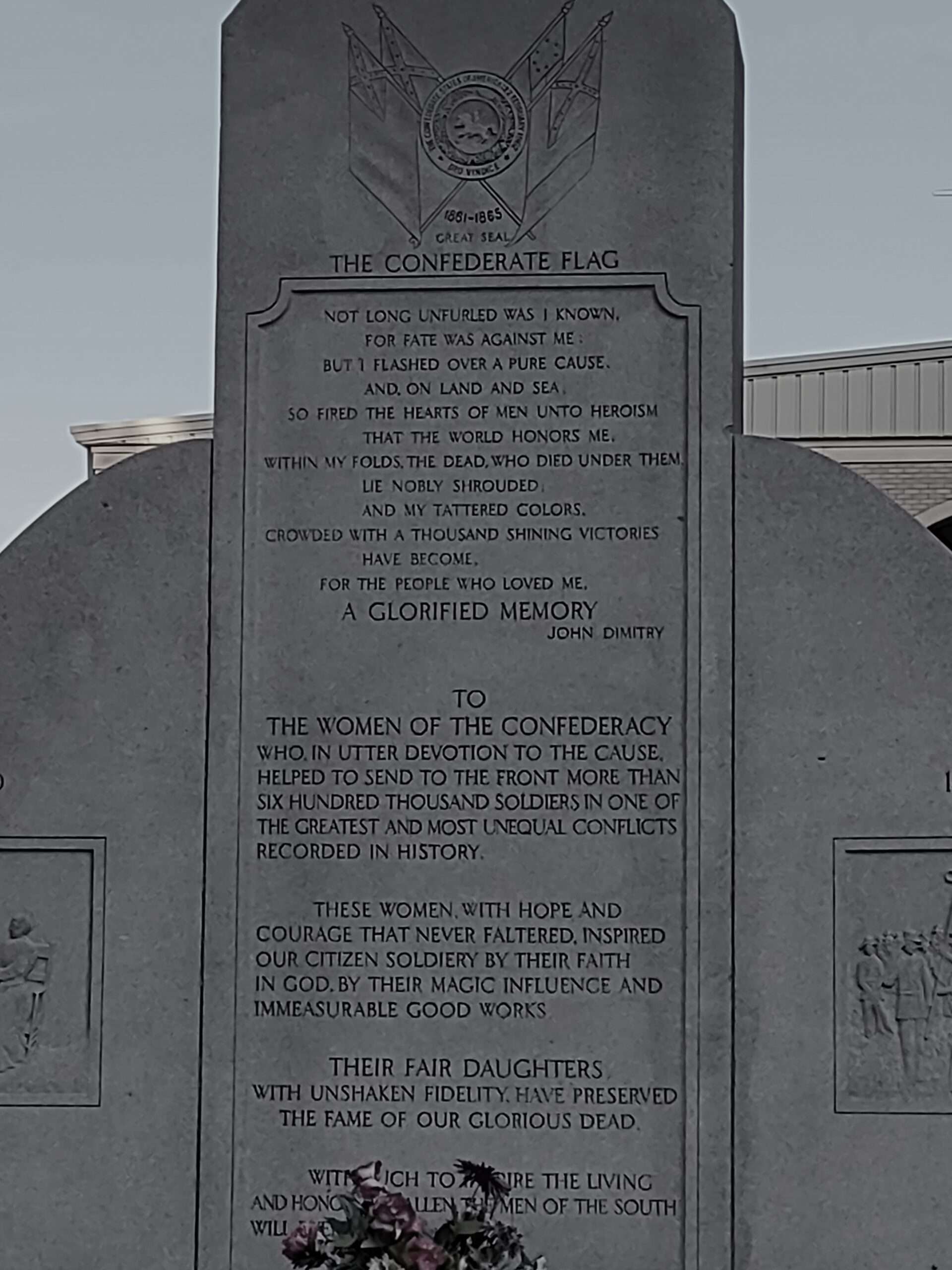
TO THE WOMEN OF THE CONFEDERACY / WHO, IN UTTER DEVOTION TO THE CAUSE, / HELPED TO SEND TO THE FRONT MORE THAN / SIX HUNDRED THOUSAND SOLDIERS IN ONE OF / THE GREATEST AND MOST UNEQUAL CONFLICTS RECORDED IN HISTORY.
THESE WOMEN, WITH HOPE AND / COURAGE THAT NEVER FALTERED, INSPIRED / OUR CITIZEN SOLDIERY BY THEIR FAITH / IN GOD, BY THEIR MAGIC INFLUENCE AND / IMMEASURABLE GOOD WORKS.
THEIR FAIR DAUGHTERS, / WITH UNSHAKEN FIDELITY, HAVE PRESERVED / THE FAME OF OUR GLORIOUS DEAD.
WITH SUCH TO INSPIRE THE LIVING / AND HONOR THE FALLEN, THE MEN OF THE SOUTH / WILL EVER BE

We have omitted the final two lines of this inscription because we would like to cover the Lost Cause Myth to aid in understanding. As previously mentioned, there are six tenets of the Lost Cause Myth.
They are:
- First, and most important, is that secession had little or nothing to do with the institution of slavery.
- Second, slavery was portrayed as a positive good; submissive, happy, and faithful slaves were better off in the system of chattel slavery which offered them protection.
- The third tenet states that the Confederacy was only defeated because of the Northern states’ numerical advantage in both men and resources.
- Fourth, Confederate soldiers are portrayed as heroic, gallant, and saintly.
- Fifth, Robert E. Lee emerged as the most sanctified figure, especially after his death in 1870.
- Sixth, Southern women also steadfastly supported the cause, sacrificing their men, time, and resources more than their Northern counterparts.
-American Battlefield Trust, The Lost Cause: Definition and Origins
This monument goes a much further into the Lost Cause Myth and contains more of its parts than the soldiers’ monument. The supposed advantage the Union held, the “glorious dead,” and the unwavering support “their fair daughters” devoted “to the cause.” This monument is the magnum opus of William Alexander Smith. How can that be when it came from an item in his will?
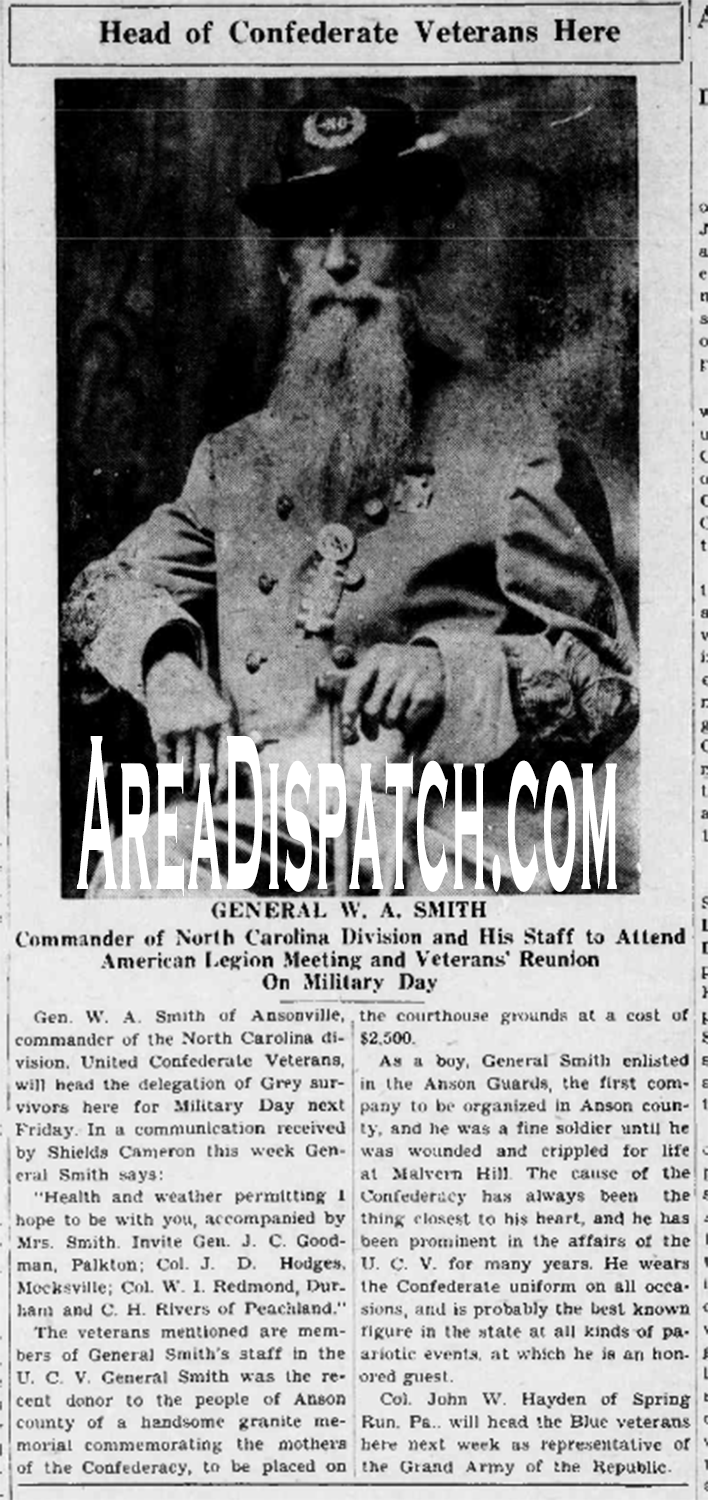
January 31, 2024: Item X of the will appears to be a cover story. Military Day was held in May, and it became Memorial Day that also falls in May. One week out from Military Day would put this article beyond the mid-April death in 1934. This seems to be a 1933 article. That would put the monument in its place over one year before it’s claimed dedication in September 1934.
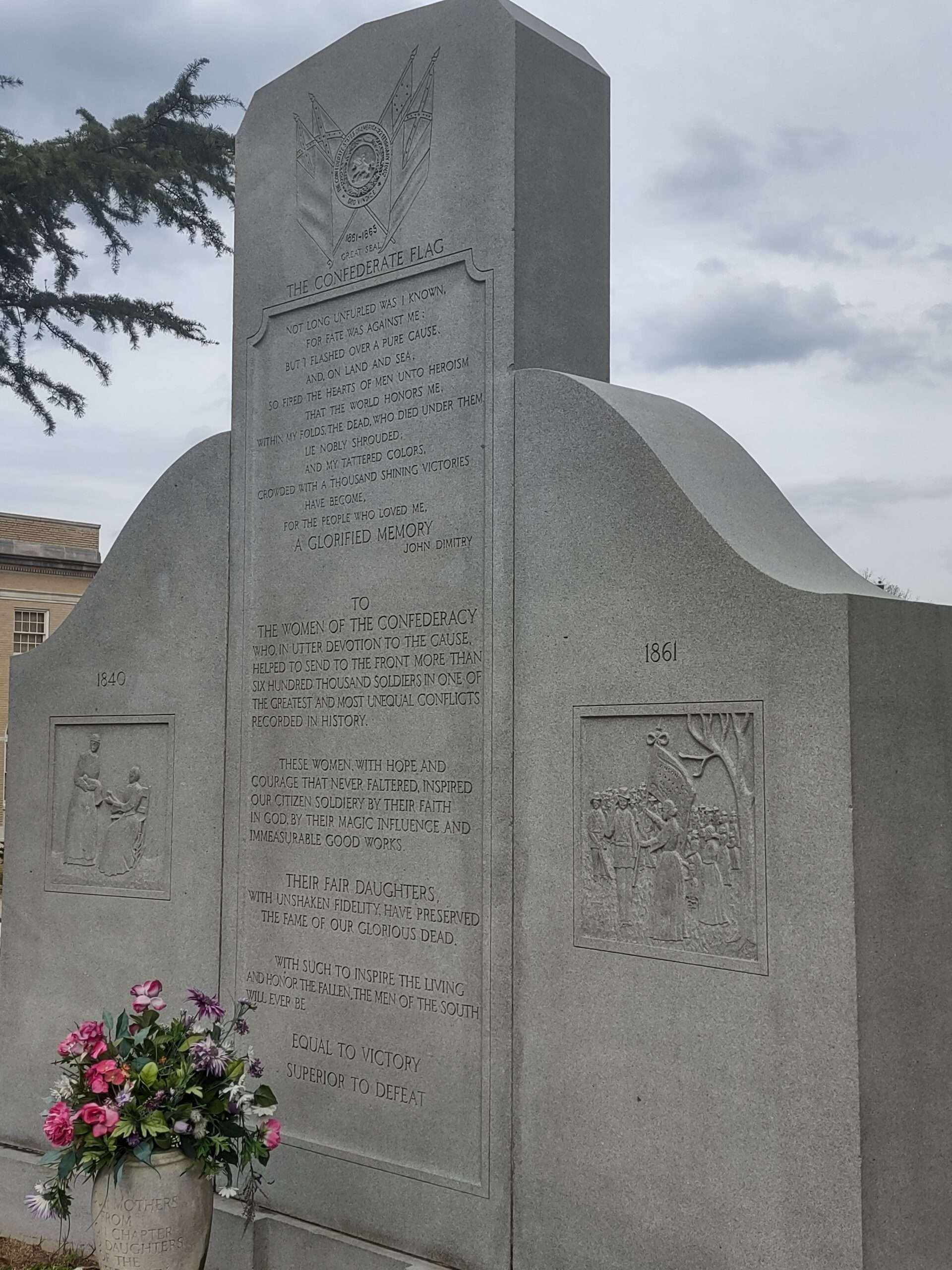
It’s shocked our team that this monument to the Women of the Confederacy, the largest one of its kind in the state, didn’t receive the public support for removal the soldiers’ monument did. In the opinion of our team, this monument does more to glorify and spread the Lost Cause Myth than any other we’ve studied. The monument honoring the North Carolina Women of the Confederacy in Raleigh was removed in 2020. There are few people that actually read and even less that understand the inscriptions on these monuments, most only take in the imagery. Imagery like a soldier standing at the Attention (Order Arms) position, atop a lofty pedestal as they walk into the courthouse for their case. The public has been appeased with the removal of the unsettling imagery, completely disregarding or ignorant to the professed belief in the institution of slavery that is affirmed on the remaining monument in front of the courthouse. The larger and more mentally damaging monument is completely ignored because of the comforting imagery of women on either side of the middle inscriptions. The first line of the larger inscription seems innocent, “To The Women of the Confederacy.” Yet, it is filled with propaganda promoting a false narrative of the Civil War that hasn’t been corrected in almost a century. It hasn’t even been questioned.
The last two lines of the primary inscription omitted earlier are:
“Equal To Victory, Superior To Defeat”
CLICK HERE to read about the Confederate surrender on April 9, 1865 @ Appomattox Court House
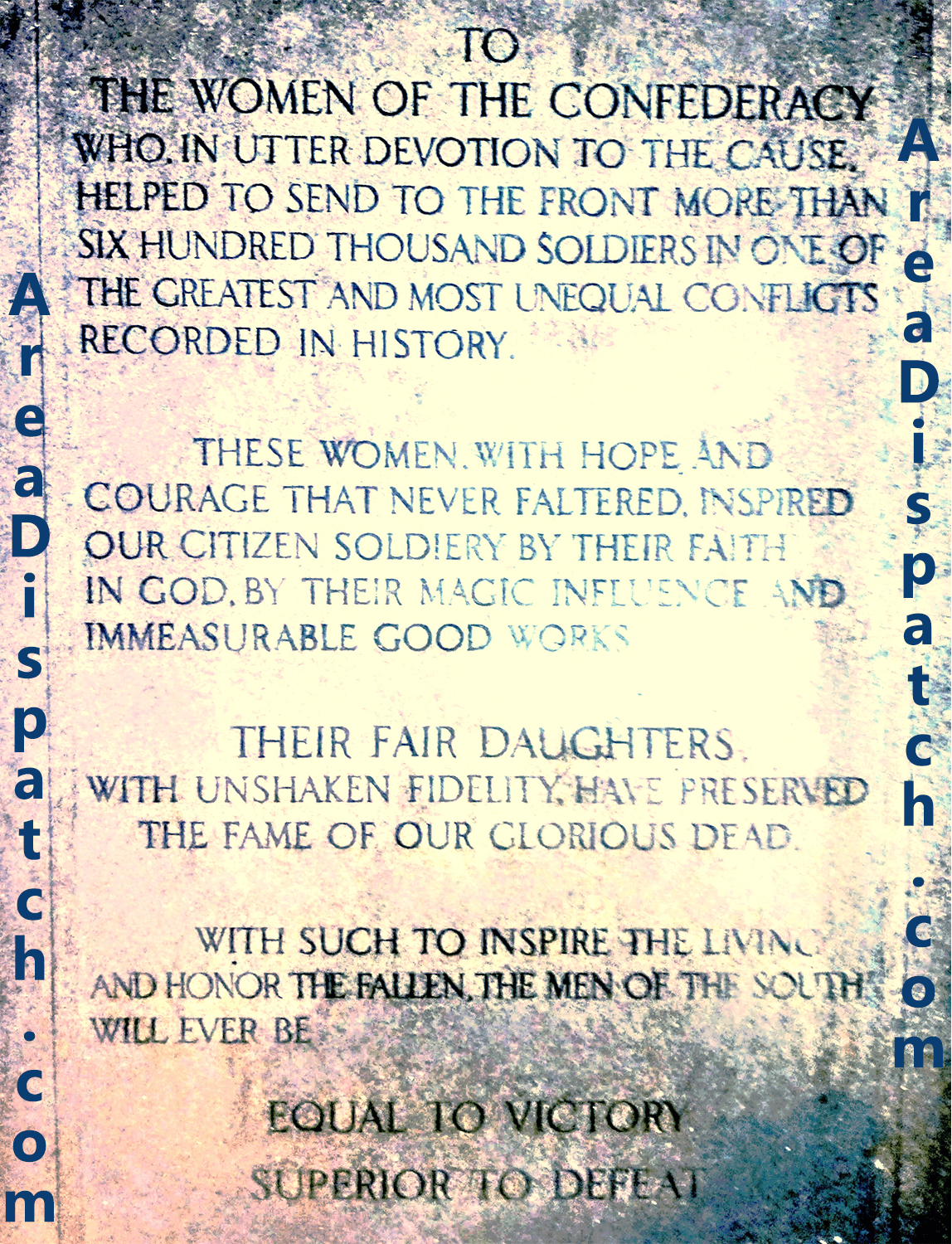
This monument is propaganda and little else. Merriam-Webster provides two definitions for ‘propaganda‘ that both accurately describe the ideas presented with this monument:
- the spreading of ideas, information, or rumor for the purpose of helping or injuring an institution, a cause, or a person
- ideas, facts, or allegations spread deliberately to further one’s cause or to damage an opposing cause
the meaning of the scenes on either side of the center inscriptions Went Unnoticed to Our Team until putting these pages together. North Carolina Civil War Monuments, An Illustrated History, by Douglas J. Butler covers this monument in surprising detail. Like the soldiers’ monument, this Anson County Confederate monument is also unique. See excerpts below:
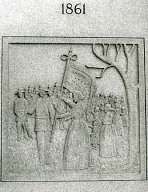
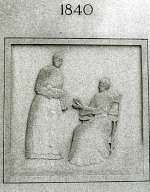
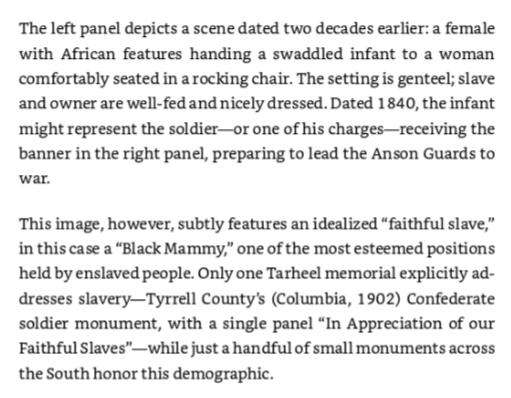
This monument does more to spread and promote the LOST CAUSE MYTH than any other in the state, possibly the nation. The messages within the inscriptions are easily decipherable and the scenes more difficult, but the imagery coupled with the romantic language Calms. The balance of this work make it surprisingly effective with its intended purpose.
“tHIS MEMORIAL IS A GIFT OF LOVE TO HIS MOTHER”
-One of these was likely written by Smith, one was probably not.
“Item X: I direct my Executor to erect a monument on the Court House lot in Wadesboro, N.C. at a cost of $2000, not to exceed three thousand dollars to my mother Eliza Sydnor Smith, to my wife Mary Bennet Smith, naming them on said monument, and to the women of the Confederacy.“
Below is another excerpt from North Carolina Civil War Monuments, An Illustrated History by Douglas J. Butler:
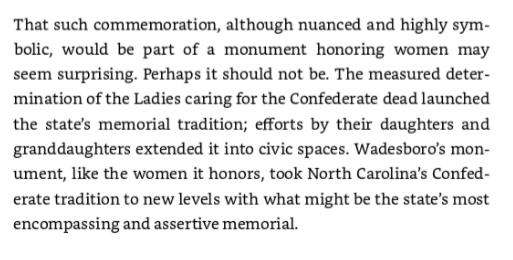

Did it come before or after the death of William Alexander Smith?
The writer of this article has seen or heard of the appearance of a “handsome granite memorial,” but it should have come with item X of Smith’s will. This article tells us that he designed this monument and had more say than including his mother and wife by name on the rear of the monument.
DEDICATED 1934
THIS MEMORIAL IS A GIFT OF LOVE TO HIS MOTHER ELIZA SNYDOR NELME SMITH AND TO MARY BENNETT SMITH AND
NANNIE FLAKE SMITH FROM WILLIAM ALEXANDER SMITH OF THE ANSON GUARDS, FIRST COMPANY IN THE STATE TO
OFFER ITS SERVICES, LATER ENROLLED, AND FOUGHT GALLANTLY THROUGHOUT THE WAR, AS COMPANY C FOURTEENTH
NORTH CAROLINA REGIMENT, CONFEDERATE STATES ARMY.
FIDELIS
The Commemorative Landscapes profile for this monument does include William A. Smith, and it provides a dedication date of September 22, 1934. Smith died in April of 1934.
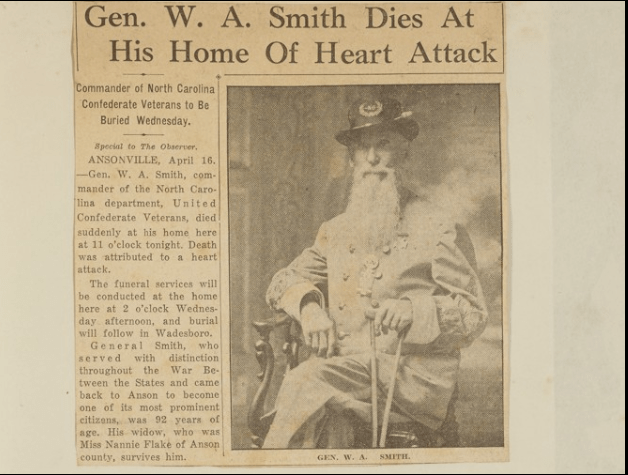
The article above includes that Smith “served with distinction throughout the War Between the States,” but we know that is false.
Did the people of his time know his factual history?
Probably not. His life, like the monuments he paid to have erected in Wadesboro, has had its true story obfuscated by false details littered throughout. From what we have read and worked to verify, almost every aspect of what was known then and is currently commonly known about his life today, was false.
We’ll provide an example of one small detail, of many, that we’ve caught. We have read several of his obituaries, all from different papers, and each includes several lies that define his life.
Each of these papers said he was 92 when he died.
He was 91 at his death.
It appears the only way he was able to create perceptions, prevent critical questioning, or outright buy others’ silence was due to being born into enormous generational wealth on both sides of his parents’ families. He was the sole heir to both fortunes, and these came with the death of his father in 1879. Charles Ebenezer Smith was cut out of the inheritance due to his change of heart at Yorktown, and his realization that he wouldn’t fight for slavery. Peace was what he would live by for the remainder of his life. Presley Nelms Smith didn’t enlist on April 30, 1861 or any other date during the war. Colonel William Gaston Smith wouldn’t allow cowards to inherit a dime.
****UPDATE: John W Hayden was a Navy Veteran and Medal of Honor Recipient. He died February 26, 1934. The story below never occurred, the Women of the Confederacy monument was in place for well over one year before it was supposedly dedicated. The will is only a cover story.
Manus McCloskey was also a Purple Heart recipient. In 1934, McCloskey’s son had been a graduate of West Point about 10 years, and was well on his way to becoming Brigadier General McCloskey too. General McCloskey had no willing part in the dedication ceremony that did not occur in September 1934.
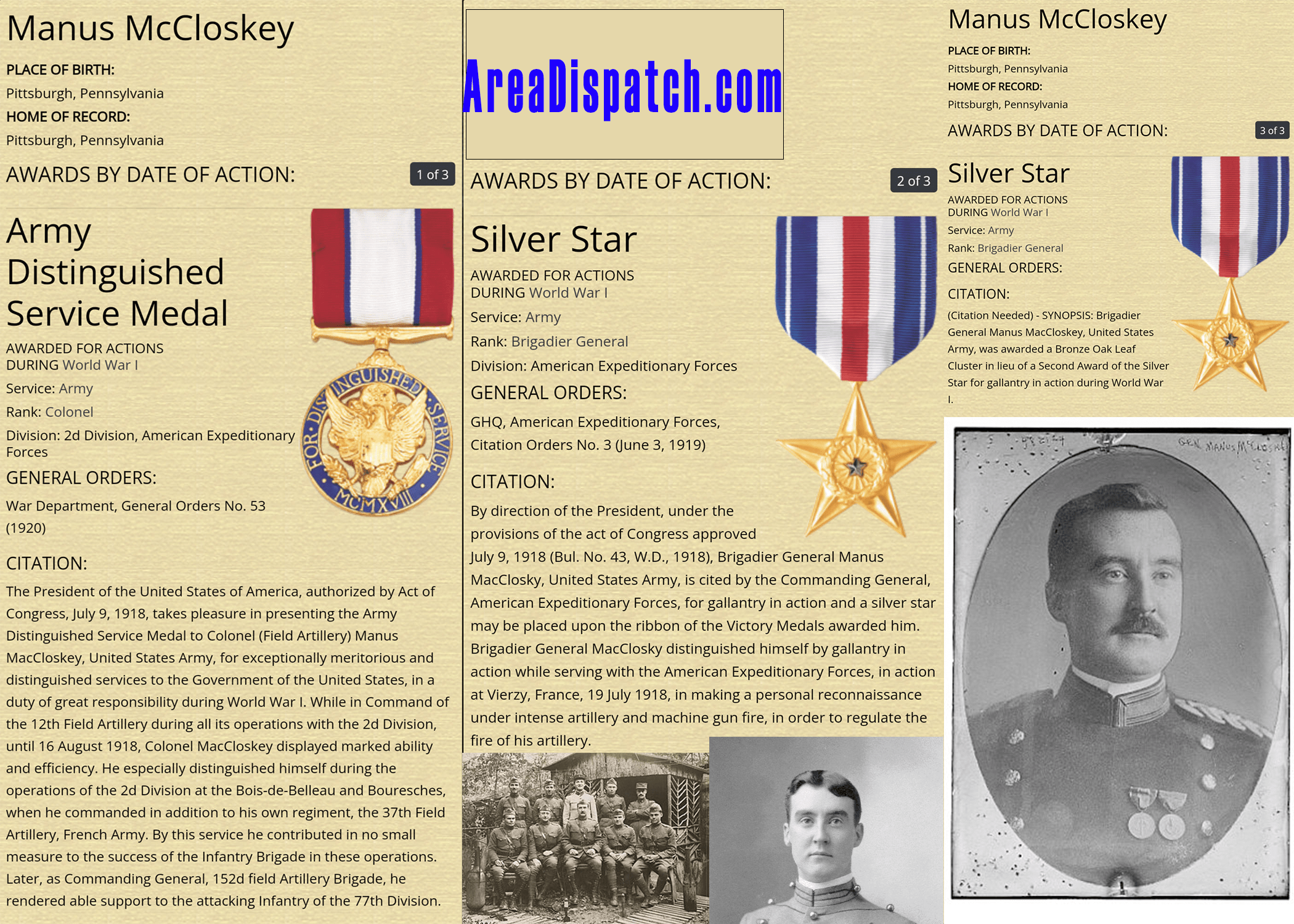
The revelation about John W Hayden highlights another inconsistency noticed with this fictional dedication ceremony. The Anson News is a newspaper registered with the Library of Congress and there are supposedly microfiche of old issues available, but we have not viewed these microfiche. The claim the Anson News was in business from September 1934 and then claiming to shut its doors in 1949. The first is supposed to be the one reporting on this dedication ceremony. We know this is a lie, and see how far individuals have gone to create fraudulent stories. See below:

Nothing to see here, just more of Smith’s lies…
Only two tenets were left out of this monument, unless the AG flag in the scene is being presented to General Lee. We may have to read all of his writings, correspondence, diaries, journals, ledgers, and anything else that may provide clarity on the meaning of these scenes. There’s little doubt in our minds that the scene to the right depicts a ‘fair’ woman of the Confederacy presenting the flag of the Anson Guard to General Lee.
To disguise five, possibly six, of the tenets of the Lost Cause Myth in ambiguity so that it remains untouched and unprotested for the life of the stone it was chiseled. This monument was obviously designed by Smith, and we question when it was erected. We have read from one source that the dedication date was January 1, 1934. The monument was apparently in existence at the time of the article above, but we also haven’t been able to confirm the paper it was from or the issue date. We’ve unsuccessfully attempted to contact the person we assume made the digital copy of the cutting, but we don’t know if they’re still alive or just very slow to respond.

Of course, that’s if it was erected around September 22, 1934. A five-month lead time on a 13-foot granite memorial would be a little tight in a time before machines did the programmed chiseling.
As part of the will, like the donation through UDC of the veterans’ monument, would remove him from the design. It would also eliminate him from allegations that he directed the placement on the portion of the courthouse grounds, and his only input would be written in the will.
The distance it is set back from the walkway on Greene Street, and from the other path to the courthouse would prevent most from ever wandering onto the kept lawn to peer at the back of this large monument. It would be perceived by most as an innocent monument to women, and the scenes would never raise alarm on their true meaning. Few would be able to decipher them.
The rear inscription is surprisingly inconspicuous, and Smith almost slipped the partially corrected fabrication past critical review.
-“FROM WILLIAM ALEXANDER SMITH OF THE ANSON GUARDS, FIRST COMPANY IN THE STATE TO OFFER ITS SERVICES, LATER ENROLLED, AND FOUGHT GALLANTLY THROUGHOUT THE WAR, AS COMPANY C FOURTEENTH NORTH CAROLINA REGIMENT, CONFEDERATE STATES ARMY.”
His enlistment date must have been questioned by someone during his life for this clarification to be included. We’ve learned that Smith intended every fabricated detail to boost his image a little bit more than the previous false detail might have. He would have loved to say that he enlisted on April 30, 1861, but he wasn’t able to do that on this meticulously concocted work; however, he did include that he “fought gallantly throughout the war” with the Anson Guard. We have seen this is not even close to the truth. There is not much worth to this ‘monument’ than propaganda value in spreading the –
Lost Cause Myth.
We’ve found a cause of our own.
Please DO NOT tear down any of these monuments after reading this investigation!!!!!!!!
The United Daughters of the Confederacy or the Sons of the Confederacy, depending on the monument, have insurance policies covering these monuments for exorbitant amounts. Removing these monuments in any way but a lawful one will only make them stronger.
CLICK HERE
to see one more thing in North Carolina that doesn’t belong and needs to go… OK, more things need to go, but baby steps



